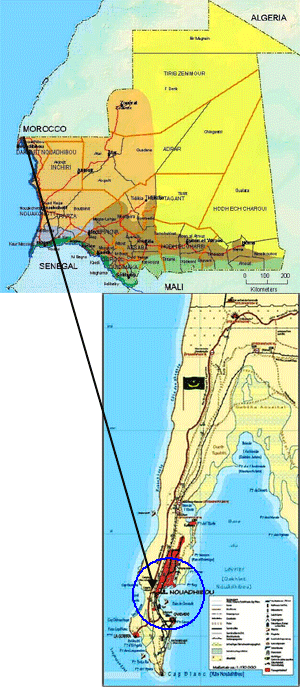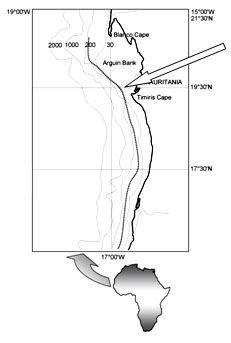HALIEUTIC RESOURCES IN MAURITANIA
Mauritania (capital city Nouakchott) is ranked amongst the world least developed countries. Its GDP in 2001 stood at 275 €uros/inhabitant and 46% of the population is living below the poverty line. Life expectancy in the country is just 55 years; the literacy rate is only 60%. Although facing many challenges Mauritania has many natural resources such as fish, crude oil and Iron ore.

In a context where more than 25% of Mauritanians are unemployed, fisheries, notably small-scale fishing and fish processing activities, are seen by public authorities as an answer to the need for jobs and the creation of added value.
The diversified Exclusive Economic Zone (EEZ) of Mauritania offers the country great potential to develop in a sustainable manner its fisheries sector, to engage in international trade, reduce poverty and increase food security.
With a total of 36 billions UM in 2001, fish exports contribute up to 50% of national exports and represent about 25% of the State budget.
Of highest exporting value are the cephalopod fisheries (mainly octopus) and demersal fisheries (noble seabed species and shrimp).
Despite the 30 000 direct and indirect employments that the fisheries sector provides, the sector has been hardly integrated into the national economy and its contribution to national GDP in real terms has been continuously decreasing from 4.5% in 1995 to 2.8% in 1999.
The halieutic resources of Mauritania EEZ are exploited by national and foreign commercial fleet and artisanal (small scale) fleets. The foreign commercial (industrial) fleet operates under chartering or licences of access agreements between the Mauritanian government and another country or under private access agreements between operators and the Mauritanian government.
Completely turned towards export markets, the Mauritanian production system experiences a lack of product diversification and processing.
The progressive scarcity of the targeted export species and the fragile health of the marine ecosystems might threaten the sustainability of the sector.
Nouadhibou is the main Mauritanian fishing harbour for both commercial and small scale fleets. The “Port Autonome de Nouadhibou” comprises three specialized wharfs with 700 m of pier and eight loading stations. One of them is totally devoted to commercial fishing with five ice making factories, several fish preservation and processing companies.
NB) 1 €uro is about 350 UM
The small scale and fishing fleet is sheltered in another neighbouring place (Etablissement Portuaire de la Baie du Lévrier) The waters off the 754-kilometer-long coast of Mauritania are among the richest fishing grounds in the world. In Mauritanian waters the commercial vessels fish outside the 12-miles zone between 20 and 60 miles off the coast - in the so-called Exclusive Economic Zone - and are monitored by local authorities, the Navy and the Coast Guard i.e. DSCM (Délégation à la Surveillance et au Contrôle Maritime).

Industrial fishing fleets can operate outside of the solid line (12 mile limit). Dashed lines show depth contours in meters.
The coastal area is reserved to Mauritanian registered artisanal and coastal fishing ships
Mauritanian EEZ has an abundant fish population thanks to the permanent activity of the Cap Blanc up-welling stream. This phenomenon induces a phyto - planctonic explosion which constitute the basis of an important food chain.
This richness of the Mauritanian waters in halieutic resources can also be explained by the role played by the coastal side of the Banc d’Arguin where the marine fauna finds favorable conditions for reproduction and development. Commercial fishing within this area is strictly prohibited.
Mauritanian waters comprises over 500 fish species, from which only 100 are commercialized.
For information, by year 2001, the total captures in the Mauritanian EEZ amounted to more 642,000 tons, among which 620,000 tons caught by the industrial fishing fleets (mostly pelagic species).


 - °
- °

